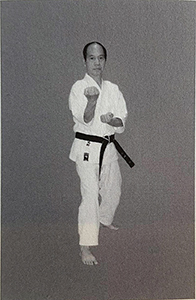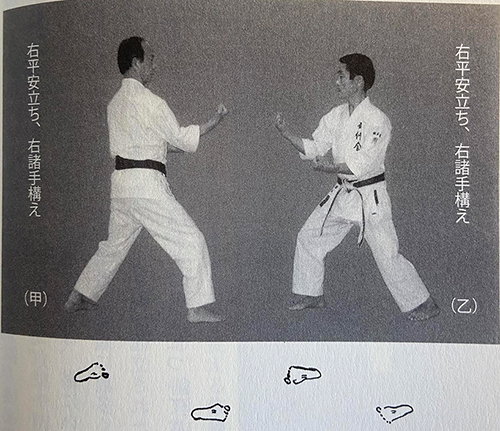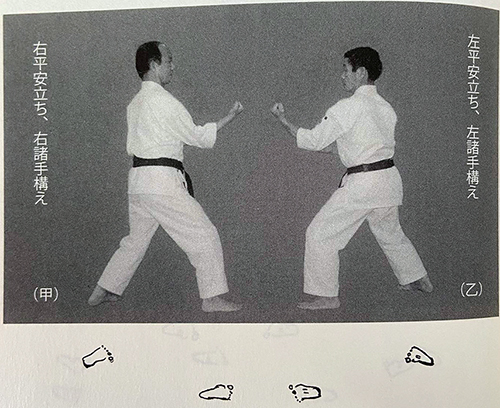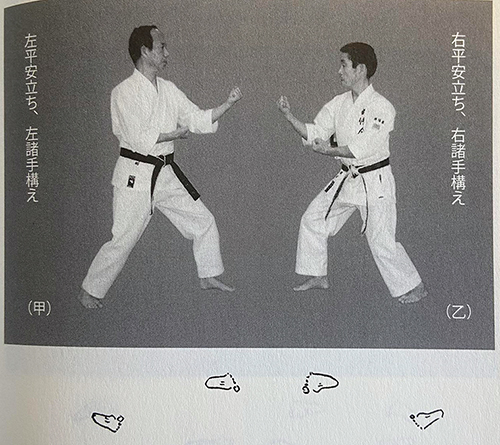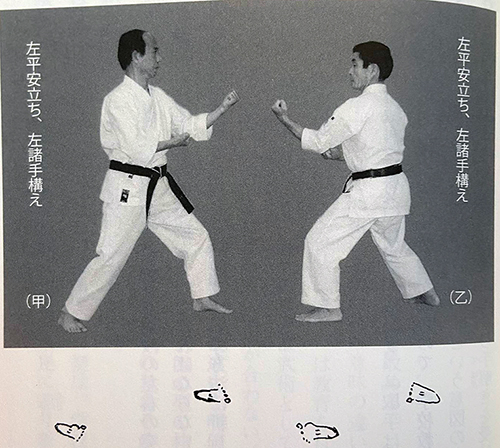(Note: The following is a partly abridged translation of a chapter from Kinjo Hiroshi’s last book. It is presented here for discussion und research purposes for those with ties to Okinawa Karate, particularly those of the Shurite genus.)
The Four Outer Forms of Postures Discovered by Matsumura
It seems that the four outer forms of postures are even found in foreign boxing textbooks. This is just what I’ve heard but haven’t confirmed myself. There is no way to know when the four postures became established in boxing. However, it is difficult to imagine they were established before Matsumura.
I believe that the four postures were not just suddenly discovered one day. I believe that reaching the state of the four postures is the result of a lifelong commitment to “achieving wisdom” (kakubutsu chichi, to deepen one’s observation and speculation about specific things). […]
Think of kenpō as a combat sport. In combat sports, winning is the priority. To win, it is necessary to be faster than your opponent, so it is essential to have superiority of speed (hands come before feet). However, speed alone is not enough to win. You must be able to respond to all of your opponent’s postures.
Unless you practice by changing your posture, speed alone will not be effective. After discovering the four postures, Matsumura realized that the four postures were not effective unless they were combined with movement. Training to capture moving objects activates the four postures. This will give you the wit to know how to take the initiative, as well as to formulate logical strategies and tactics.
The Meaning of “Posture” (kamae)
The word “posture” (kamae) has many meanings. Here, I would like you to understand it in the narrower sense of “an offensive or defensive posture.” Generally, it is said that there are various postures (kamae) used for karate. However, I think that the fundamentals lie in the four simple outer forms of postures (kamae) discovered by Matsumura. […]
Two-handed posture (Morote-kamae)
As shown in illustration 1, when your right hand is in the front, you have the “right two-handed posture” (migi morote kamae).
(Translator’s note: In all photos, A is on the left, and B is on the right.)
Stand a little higher, just as shown in illustration 1. This is the stance of Pinan created by Itosu Ankō. As shown in illustration 1, if the right foot is in front, it becomes “right Pinan-dachi.”
In illustration 2, both A and B are in “right Pinan-dachi with a right two-handed posture.” If you stand in the opposite fashion, it becomes “left Pinan-dachi with a left two-handed posture.”
For a single person, there are only two basic forms of stances, i.e., left, and right. However, if two people team up, the number will double to four.
The traditional old kata often start from the right posture. This is probably to protect the important heart.
For convenience, I will number the four outer forms of postures. The first form of right stance versus right stance will be the First Outer Form of Postures.
1) First Outer Form of Postures
As shown in illustration 2, A is in right Pinan-dachi, with right two-handed posture, and B is also in right Pinan-dachi with right two-handed posture. Both are in the same posture.
2) Second Outer Form of Postures
As shown in illustration 3, A is the same as in the First Outer Form of Postures, i.e., right Pinan-dachi with right two-handed posture. B is in the left Pinan-dachi with left two-handed posture.
3) Third Outer Form of Postures
As shown in illustration 4, A is in left Pinan-dachi, with left two-handed posture. B is in right Pinan-dachi, with right two-handed posture. Note that in this form and the positions of A and B are opposite to each other than in the Second Outer Form of Postures.
4) Fourth Outer Form of Postures
As shown in illustration 5, A is in left Pinan-dachi, with left two-handed posture. B is also in left Pinan-dachi with left two-handed posture.
The posture is second outer form on the left and right when used alone, and the Fourth Outer Form of Postures when assuming an opponent.
Do you understand? Maybe because it is so straightforward and simple, when I ask people to explain it, I often see them confused and unable to explain it clearly and in an orderly manner, maybe because the four postures are so similar.
The four outer forms of postures are not just four models according to or beyond the kata. From the four postures, the mathematical logic can be derived that one technique is developed into four techniques. For example, if we consider a right-hand thrusting technique, if we apply it to the four outer forms of postures, when viewed from B’s side, four kinds of thrusts are created as follows.
- (1) A: right posture / B: right chūdan-zuki, right foot forward
- (2) A: right posture / B: right chūdan-zuki, left foot forward
- (3) A: left posture / B: right chūdan-zuki, right foot forward
- (4) A: left posture / B: right chūdan-zuki, left foot forward
If you add a left chūdan-zuki, it will become a total of eight chūdan-zuki (four with the right, and four with the left fist). If you then add left and right jōdan-zuki, the total number doubles to sixteen. If this is the case, then there must also be sixteen defensive techniques corresponding to this.
If we can understand the trend of development of the four postures as mentioned above, I believe that a new way of teaching methods opens for [karate as] a combat sport.
Translator’s Addendum
I have a few questions in relation to this text.
- How did Kinjo Hiroshi know that Matsumura discovered “Four Outer Form of Postures”?
- Why were these not handed anywhere else in in Okinawa?
- Did Kinjo Hiroshi, who came from a school karate background, change his few on karate over time?
- Are there other martial arts that discovered similar concepts?
© 2023, Andreas Quast. All rights reserved.

